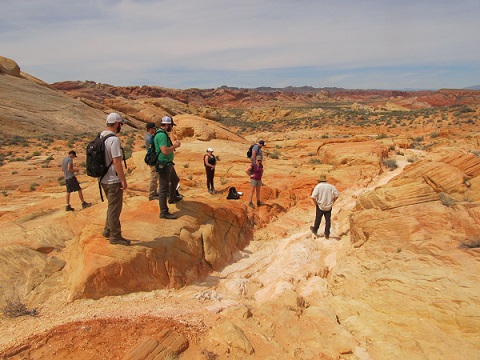
Structural Geology of Extension, Compression, and Strike-Slip in Clastic and Carbonate Systems
Course Details
What better place to study structural geology than a desert where it is all exposed! This field course offers participants a chance to study extensional deformation in the Muddy Mountains just east of Las Vegas as well as contractional deformation from the Sevier Orogeny in the Spring Mountains just west of Las Vegas. Complexity within these systems results in both strike-slip and inversion to occur along fault blocks making this study area the full package.
The Valley of Fire displays incredible fracture patterns at the reservoir scale while preserving the sequence of deformation from initial development of shear fracturing up to larger faults. Participants will be able to put their finger on an early shear zone consisting of small fractures and then just a short hike away, be able to stand on kilometer long faults from that same system. We will discuss the evolution of these types of fracture systems and how they play a role in reservoir compartmentalization. We will also discuss fault linkage in a strike-slip system and look at structural models to predict zones of contraction and tension.
A regional thrust sheet overrode the Muddy Mountains during the Sevier Orogeny which then became sliced up during Basin and Range extension leaving behind several unique klippes, or remnant thrust sheets. Participants will be able to see these klippes up close and understand how multiple tectonics events shaped the region. We will also look at the impact of mechanical stratigraphy on larger faults and how the damage zone associated with the faults may differ depending on if the host rock is carbonate or clastic-rich. Precambrian rift faults resulted in pre-existing discontinuities for later deformation leading to both inversion and strike-slip faulting in the Muddy Mountains during Basin and Range extension.
A full day hike through Arrow Canyon reveals incredible carbonates of Mississippian through Pennsylvanian age. Key concepts include understanding the impact of natural fractures on a carbonate reservoir, the role of mechanical stratigraphy, normal faulting and associated dissolution and karst collapse, and structures commonly associated with major thrust faults including duplexes, tight folds, and hangingwall/footwall cutoffs.
In the Spring Mountains participants will be able to put their finger on the famous Keystone thrust fault and observe the architecture of a major thrust fault. We will also view an exposed large footwall syncline under the infamous Keystone Thrust Fault in the Red Rock Canyon National Conservation Area and talk about the kinematics of a fold and thrust belt.
Who Should Attend
• Geologists
• Geophysicists
• Petrophysicists
• Engineers
This course is meant for those making structural interpretations in seismic data, constructing regional tectonic models, and working in systems that underwent multiple tectonic events. Events include rift faulting, fold and thrust belts, and strike-slip systems that develop within these types of systems. Structural models can be crucial for exploration and development. This course will provide participants with multiple models and analogues that can be applied back at the office.
Need more information?
Course Outline
Day 1
- You will be arriving the day before the course starts in Las Vegas, Nevada, USA. The next morning, we will begin with a safety briefing, orientation to the field area and an introduction to structural geology.
- We will begin the field trip with a hike in the Valley of Fire where we will analyze reservoir scale fracturing in the Jurassic Aztec Sandstone alongside strike-slip faulting.
- After lunch we will observe different fracture sets and types related to multiple events, followed by analyzing the architecture of strike-slip faults at the outcrop scale.
- We will hike along the Willow Tank thrust fault and observed the kinematic indicators of a major thrust fault.

Day 2
- A full day of hiking through Arrow Canyon looking at fractured carbonates
- Early in the hike we introduce the concept of mechanical stratigraphy and the impact of fracturing.
- We do several exercises taking scan lines and estimating fracture porosity and permeability.
- Extensional structures throughout the canyon provide exceptional 3D views of fault evolution illustrating early fault initiation followed by the fault fully cutting the section.
- Deep in the canyon, which sits on the hangingwall of a major thrust fault, we see duplex structures along with both fault-bend and fault-propagation folds. Near the end of the hike the canyon provides text-book examples of karst structures from dissolution fractures and faults to paleo-sink holes as a result of karst collapse.

Day 3
- We will look at extensional faulting in carbonate-rich rocks, as well as at multiple scales.
- Participants will construct regional scale cross sections based on satellite imagery, outcrop, and geologic models.
- A short hike will take us to a large strike-slip fault that developed in an extensional regime and we will discuss the kinematics of how this occurred.
- We’ll end the day viewing of a large pop-up structure along a regional strike-slip fault system and discuss how these structure develop.

Day 4
- We will start by hiking along a dry riverbed to observe a fractured reservoir in the damage zone of a larger extensional fault.
- We’ll view and review the kinematics of fault-propagation folding.
- A second hike will take us to extensional release faults that developed in response to a larger normal fault that we’ll discuss along with relay ramps.
- Lastly, we will observe smaller scale strike-slip faults along an erosional wall in response to interactions between a larger system. This is a great area to see folding and faulting along strike and along dip.

Day 5
- Hike the Keystone Thrust Trail at the Red Rock Canyon National Conservation Area.
- Put our finger on the thrust fault and discuss the architecture of a major fault plane and how it’s physically possible to move so much rock.
- The second hike of the day includes a famous viewpoint of the Keystone Thrust Fault and exposure of a large footwall syncline.
We will be dropping you off at Las Vegas Airport for an evening departure.

This field trip will run March, 2025. The cost of the field trip is $7000 and this includes tuition, course manual and exercise materials, 5 nights hotel stay, breakfasts-lunches-dinners, snacks and drinks in the field, transportation, fuel, and national parks passes.
If you are overseas and intend on going on this trip we strongly urge applying for a US visa with our letter of invitation no later than August 2024.


